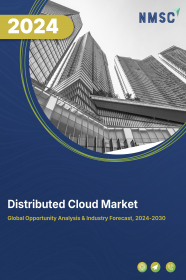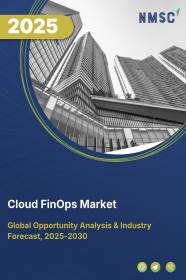
Distributed Cloud Market by Type (Public-resource Computing and Volunteer Cloud Computing), by Application (Edge Computing, Content Delivery, Intelligent Transportation, and Others), by Enterprise Size (Large Enterprises and SMEs), by Industry Vertical (BFSI, Government & Defense, Retail & E-commerce, Healthcare, IT & Telecom, Energy & Utilities, Manufacturing, Media & Entertainment, and Others)- Global Opportunity Analysis and Industry Forecast, 2024-2030
Market Definition
The Distributed Cloud Market size was valued at 4.44 Billion in 2023 and is predicted to reach 16.19 Billion by 2030 at a CAGR of 20.3% from 2024 to 2030. A distributed cloud is a decentralized computing model where cloud resources and services are dispersed across multiple physical locations or data centers. Unlike traditional centralized cloud setups, a distributed cloud architecture distributes computing assets geographically, offering several benefits such as improved fault tolerance, reduced latency through edge computing, and enhanced scalability. By spreading resources across various regions, distributed clouds ensure data sovereignty and compliance with local regulations while optimizing performance and resilience against disruptions. This approach facilitates efficient resource utilization and fosters agility in adapting to changing demands, making distributed cloud an increasingly preferred solution for modern applications and organizations.
Market Dynamics and Trends
The demand for distributed cloud is increasing due to the rising adoption of cloud architecture in the healthcare industry to support a variety of applications, including electronic health records (EHRs), telemedicine, and data analytics. Also, distributed cloud computing technologies provide real-time data processing for businesses.
Through the implementation of distributed cloud systems, organizations can enhance customer experiences by focusing on innovative strategies driven by accurate, reliable, and consistent data. Distributed cloud computing technologies provide businesses the flexibility to customize their products to create durable relationships with their customers, which in turn fuels the growth of the market.
Moreover, the launch of new products, an increase in government interest in implementing and promoting cloud technologies, and quick adoption of cloud technology for a wide range of applications fuel the growth of the distributed cloud market.
For instance, in November 2022, the Data Security Council of India (DSCI) collaborated with Google Cloud and announced the ‘Secure with Cloud’ initiative to help demystify cloud security and enable the government and private sector to deploy and encourage cloud transformation in India.
However, the substantial upfront investment required set up and manage distributed cloud infrastructure. This includes costs for hardware, software tools, and skilled personnel. As a result, smaller businesses with limited budgets find it challenging to afford these initial expenses, hindering their ability to adopt distributed cloud solutions. This acts as a restraining factor for the growth of the distributed cloud market.
On the contrary, with the increasing popularity of the cloud, many organizations prefer a multi-cloud strategy to allow more flexibility, scalability, and cost savings. This strategy involves using multiple cloud providers to host different workloads and applications, allowing businesses to take advantage of the different strengths of each provider, which is expected to create ample growth opportunities for the market in the future.
Market Segmentation and Scope of Study
The global distributed cloud market is segmented on the basis of type, application, enterprise size, industry vertical, and region. Based on type, the market is classified into public-resource computing and volunteer cloud computing. Based on the applications, the market is segmented into edge computing, content delivery, intelligent transportation, and others. On the basis of enterprise size, the market is categorized into large enterprises and SMEs. On the basis of industry vertical, the market is divided into BFSI, government and defense, retail and E-commerce, healthcare, IT and telecom, energy and utilities, manufacturing, media and entertainment, and others. The geographical breakdown and analysis of each of the aforesaid classifications include regions comprising North America, Europe, Asia-Pacific, and RoW.
Geographical Analysis
North America dominates the global distributed cloud market and is projected to remain dominant in the market throughout the forecast period. This is attributed to the rising adoption of cloud computing by business organizations in the region to scale up/scale down their resources as needed using distributed cloud architectures.
Moreover, presence of key market players in the region, such as Amazon Web Services, Google, IBM, and Oracle Corporation, underscores the competitive landscape and growth potential of the distributed cloud market. These established industry giants bring extensive experience, robust infrastructure, and innovative solutions, driving advancements in distributed cloud technologies and shaping market dynamics.
Their involvement signifies significant investment and commitment to meeting the evolving needs of customers for distributed computing solutions, further fueling the expansion and maturation of the distributed cloud market in the region.
For instance, In February 2022, IBM acquired Sentaca, a provider of telco consulting services and solutions, to improve its hybrid cloud abilities with Sentaca. Through this acquisition, Sentaca’s cloud-native application testing, development, and future network capabilities would make an excellent addition to what the company has been working on in recent times.
Also, in June 2022, Oracle Cloud introduced a new distributed cloud service. The new services would assist customers in achieving data ownership, stringent latency, and data protection demands, all of which are critical to various IT modernization initiatives.
On the other hand, Asia–Pacific shows substantial growth in the global distributed cloud market owing to the rapid growth of smart devices in the region along with the emergence of the 5G network as it can help to improve the performance, scalability, and reliability of cloud services, which in turn accelerates the demand for the distributed cloud market.
Moreover, the rising demand for digital transformation and adoption of various strategies with huge investments by regional organizations in cloud computing and distributed cloud solutions further boosts the growth of the distributed cloud market.
For instance, in March 2022, Alibaba Cloud unveiled its cloud computer in Singapore, with the addition of both the pocket-sized Wuying cloud computer and Elastic Desktop Service (EDS). Through this rise in remote workforces in Asia, Alibaba Cloud would make it simpler for firms to use heavy computer-powered productivity apps, such as computer-aided design (CAD) software.
Competitive Landscape
The distributed cloud market includes several market players such as Google, IBM Corporation, Microsoft Corporation, Amazon Web Services, VMware Inc., Alibaba Cloud, Teradata Corporation, Oracle Corporation, Cohesity, and F5 Inc. These market players are adopting various strategies, such as launches and collaborations, to maintain their dominance in the global distributed cloud market.
For instance, in July 2022, Amazon Web Services introduced AWS Cloud WAN, a new managed broad area network. The new solution combines on-premises data centers, storage facilities, branch offices, and cloud resources to ease global network operations. Furthermore, by utilizing a unified management dashboard included in AWS Cloud WAN, customers can assess their network configuration, evaluate the health of their global network, and automate standard design and safety activities.
Also, in April 2022, VMware collaborated with Deloitte to develop the Deloitte VMware Distributed Cloud (DVDC) practice to assist customers in transforming their operations and the industries they serve by more efficiently deploying and using distributed cloud architectures.
Key Benefits
-
The report provides quantitative analysis and estimations of the distributed cloud market from 2024 to 2030, which assists in identifying the prevailing market opportunities.
-
The study comprises a deep dive analysis of the distributed cloud market including the current and future trends to depict prevalent investment pockets in the market.
-
Information related to key drivers, restraints, and opportunities and their impact on the distributed cloud market is provided in the report.
-
Competitive analysis of the players, along with their market share is provided in the report.
-
SWOT analysis and Porters Five Forces model is elaborated in the study.
-
Value chain analysis in the market study provides a clear picture of roles of stakeholders.
Key Market Segments
By Type
-
Public-resource Computing
-
Volunteer Cloud Computing
By Application
-
Edge Computing
-
Content Delivery
-
Intelligent Transportation
-
Others
By Enterprise Size
-
Large Enterprises
-
SMEs
By Industry Vertical
-
BFSI
-
Government and Defense
-
Retail and E-commerce
-
Healthcare
-
IT and Telecom
-
Energy and Utilities
-
Manufacturing
-
Media and Entertainment
-
Others
By Region
-
North America
-
The U.S
-
Canada
-
Mexico
-
-
Europe
-
The UK
-
Germany
-
France
-
Italy
-
Spain
-
Denmark
-
Netherlands
-
Finland
-
Sweden
-
Norway
-
Russia
-
Rest of Europe
-
-
Asia-Pacific
-
China
-
Japan
-
India
-
South Korea
-
Australia
-
Indonesia
-
Singapore
-
Taiwan
-
Thailand
-
Rest of Asia-Pacific
-
-
RoW
-
Latin America
-
Middle East
-
Africa
-
Key Players
-
Google LLC
-
IBM Corporation
-
F5 Inc.
-
Microsoft Corporation
-
Amazon Web Services
-
VMware Inc.
-
Alibaba Cloud
-
Teradata Corporation
-
Oracle Corporation
-
Cohesity
REPORT SCOPE AND SEGMENTATION:
|
Parameters |
Details |
|
Market Size in 2023 |
USD 4.44 Billion |
|
Revenue Forecast in 2030 |
USD 16.19 Billion |
|
Growth Rate |
CAGR of 20.3% from 2024 to 2030 |
|
Analysis Period |
2023–2030 |
|
Base Year Considered |
2023 |
|
Forecast Period |
2024–2030 |
|
Market Size Estimation |
Billion (USD) |
|
Growth Factors |
|
|
Countries Covered |
28 |
|
Companies Profiled |
10 |
|
Market Share |
Available for 10 companies |
|
Customization Scope |
Free customization (equivalent to up to 80 working hours of analysts) after purchase. Addition or alteration to country, regional, and segment scope. |
|
Pricing and Purchase Options |
Avail customized purchase options to meet your exact research needs. |




















 Speak to Our Analyst
Speak to Our Analyst
























